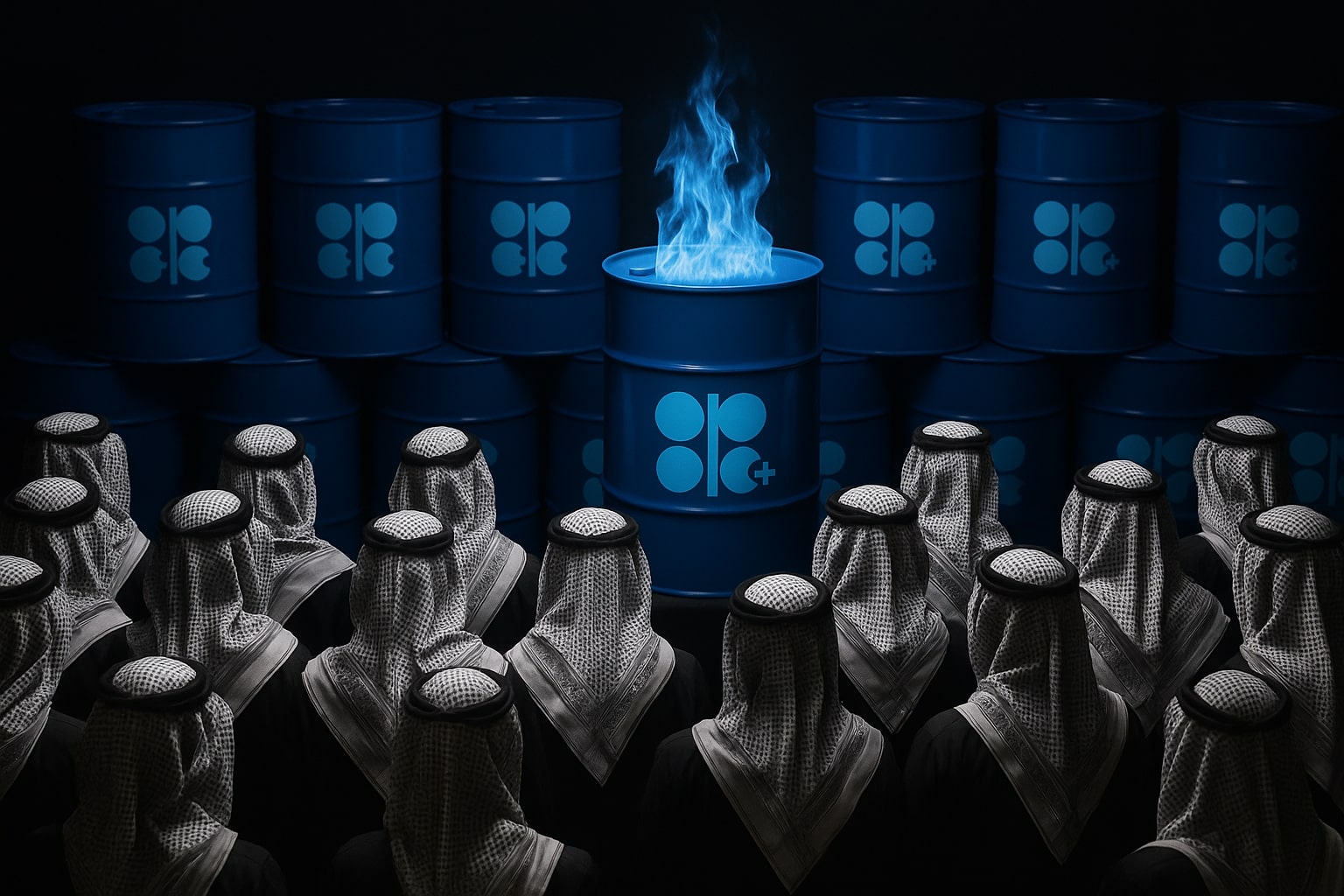
Oil Price Forecast - Oil Prices Edge Higher as Sanctions Tighten Russian Supply and Oversupply Fears Limit Gains
WTI (CL=F) rose to $61.01, while Brent (BZ=F) hit $65.10, supported by U.S. sanctions on Russia and Indian refiners’ shift to Saudi and Iraqi barrels | That's TradingNEWS
WTI (CL=F) and Brent (BZ=F) fight between sanctions and oversupply
WTI crude rebounds as sanctions tighten Russian exports
West Texas Intermediate (CL=F) moved near $61.01 per barrel, rising 1.46%, as U.S. sanctions against Russian producers disrupted regional supply chains. Traders shifted attention to constrained refined product flows after Lukoil declared force majeure at its Iraqi operations, forcing rerouting of over 250,000 barrels per day of crude. Restricted Russian exports gave temporary support to WTI futures, but the bounce remains shallow. The market continues to digest higher U.S. output and rising inventories, with Energy Information Administration data showing American crude stockpiles hovering near 430 million barrels, up nearly 4% month-over-month. The 200-day EMA sits just above $61.30, signaling a consolidation zone rather than a structural recovery.
Brent (BZ=F) holds gains but faces heavy resistance near $65
Brent crude remains trapped between $64.50 and $65.50, unable to break through technical resistance tied to the 50-day EMA near $65.8. While sanctions on Russian exporters are tightening the refined fuel market, the physical crude balance is leaning bearish. OPEC+ has already raised production by 137,000 barrels per day for December and plans to hold output steady through the first quarter. Commerzbank data suggests total OPEC+ supply additions of nearly 2 million bpd since April, creating a global buffer of unwanted barrels despite sanctions-driven disruptions. European refiners, particularly in France and the Netherlands, report higher seaborne inventories, highlighting that demand recovery remains weak compared with midyear expectations.
Indian refiners shift crude strategy amid U.S. sanctions pressure
New sanctions are forcing India’s refiners—historically top buyers of Russian Urals—to pivot sharply toward Middle Eastern barrels. State refiners including Indian Oil, Bharat Petroleum, and HPCL have increased December allocations from Saudi Arabia, Iraq, and Kuwait by a combined 600,000 barrels per day, marking India’s largest single-month shift since 2022. The move supports short-term Brent demand but weakens Russian spot discounts in Asia. India’s ONGC, the country’s biggest producer, reported a 17.8% drop in net profit to $1.11 billion, driven by weaker crude realizations averaging $67.34 per barrel, down from $78.33 a year earlier. This reinforces how sustained low prices are squeezing upstream margins even for state-backed producers.
Nigeria eyes production rebound but infrastructure risks persist
Nigeria’s upstream regulator approved 43 new field development plans this year, unlocking an estimated 1.7 billion barrels of crude and 7.7 trillion cubic feet of natural gas, representing nearly $20 billion in new investment. Yet systemic challenges persist: a parliamentary audit estimates $300 billion lost to theft and pipeline vandalism over the past decade. Current output ranges between 1.7–1.83 million barrels per day, still below the government’s 2 million bpd goal for 2026. With Big Oil majors reducing exposure and selling onshore assets, Nigeria’s recovery hinges on infrastructure protection and offshore investment consistency. If successful, the country could reclaim its status as sub-Saharan Africa’s leading exporter by the end of the decade.
U.S. output expands but refiners show margin strain
U.S. crude production remains close to 13.3 million barrels per day, just shy of record highs, with shale basins continuing to post incremental growth. However, refining margins are tightening—Gulf Coast crack spreads slipped below $12 per barrel, signaling weaker profitability despite strong throughput. The Biden administration’s limited SPR refill, involving just a single symbolic 1-million-barrel purchase, has done little to stabilize prices or absorb excess inventory. Traders note that U.S. drillers are maintaining output discipline yet remain unwilling to significantly cut supply ahead of an election year. The result is an uneasy equilibrium: high production, flat demand, and political reluctance to curb exports.
OPEC+ struggles to balance compliance and credibility
Inside OPEC+, cohesion is fraying. While Saudi Arabia continues to anchor voluntary cuts near 9 million bpd, several secondary members—including Iraq, Kazakhstan, and Nigeria—have exceeded quotas for four consecutive months. Analysts warn that OPEC+ is adding as much as 1 million barrels per day of oversupply beyond agreed limits, offsetting the benefits of Russian export disruptions. The group’s December adjustment of 137,000 bpd underscores its delicate balancing act: signaling discipline while quietly expanding volumes to retain market share. If Brent remains capped below $66, internal pressure for deeper 2026 cuts will intensify, potentially reshaping the group’s cohesion heading into the next Vienna meeting.
Geopolitical backdrop and U.S. policy tailwinds
Oil’s volatility reflects the intersection of sanctions, politics, and fiscal policy. Optimism surrounding the end of the U.S. government shutdown boosted WTI demand temporarily as traders priced in a modest uptick in consumption tied to federal reopenings. Meanwhile, Washington’s 12.5% Gulf royalty adjustment under the new energy auction law has renewed private-sector interest in domestic exploration, particularly in the Permian and Eagle Ford regions. In parallel, European authorities intensified scrutiny of the “shadow fleet” transporting sanctioned Russian oil through secondary routes such as the Baltic and Indian Ocean, tightening insurance compliance and vessel tracking. This has constrained roughly 300,000 barrels per day of shipments, mainly to Mediterranean refiners, supporting marginal short-term price stability.
Read More
-
JEPI ETF Edges to $57.11 as Yield Holds Above 8% and Covered-Call Premiums Power Income
11.11.2025 · TradingNEWS ArchiveStocks
-
XRP ETFs Slide — XRPI Down to $14.18 and XRPR to $19.80 as Investors Lock In Gains After Record Run
11.11.2025 · TradingNEWS ArchiveCrypto
-
Natural Gas Price Steadies Near $4.40 as Record U.S. Supply and Weather Volatility Define Market
11.11.2025 · TradingNEWS ArchiveCommodities
-
USD/JPY Price Forecast - Yen Holds Near 154.00 as Yen Slides and Market Awaits Fed-BoJ Policy Shift
11.11.2025 · TradingNEWS ArchiveForex
Technical picture: critical inflection between $60 and $62 for WTI
The $60–$62 range remains the core battlefield for CL=F futures. The 50-day EMA near $61.8 and the 100-day EMA at $62.1 form a double resistance ceiling. A daily close above $62.5 would signal momentum rotation toward $64.2, but failure to sustain above $60 could reignite selling toward $58.7, the mid-October low. The Relative Strength Index (RSI) sits neutral at 49, leaving room for either breakout or renewed correction. Brent mirrors this dynamic, with $65.8 acting as a resistance barrier and $63 as first support. Both contracts show declining open interest, indicating fading speculative conviction rather than aggressive short positioning.
Long-term structural picture: fragile balance of fear and supply
The oil market’s structural narrative remains divided. Sanctions risk has reintroduced a geopolitical premium estimated at $2–$3 per barrel, but the physical oversupply continues to dominate price formation. Inventories across OECD nations stand at 2.83 billion barrels, roughly 3% above the five-year average, keeping any sustained rally capped. The shift in trade flows—India pivoting to Middle Eastern crude, China’s flat CO₂ emissions signaling slower industrial demand, and Europe accelerating renewables under Norway’s $2.1 trillion fund—marks a long-term redistribution of demand rather than outright expansion.
Final Take — WTI (CL=F) and Brent (BZ=F) Verdict
Oil’s rebound above $61 for WTI and $65 for Brent looks tactical, not structural. The balance between sanctions-driven short squeezes and fundamental oversupply remains unresolved. U.S. production discipline, OPEC+ disunity, and soft demand in Asia all limit upside. Until WTI breaks $62.5 with conviction, the bias leans neutral to bearish. WTI (CL=F) is a Hold, leaning Bearish short term, while Brent (BZ=F) remains a Hold to Buy only above $66.50. The next decisive catalyst will likely emerge from either a deeper OPEC+ cut or a geopolitical escalation capable of removing real barrels from the market—otherwise, crude remains trapped in its $58–$66 range.



















